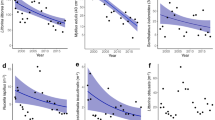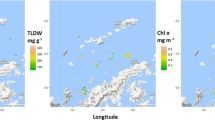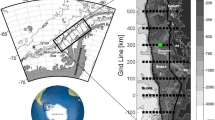Abstract
Krill (Euphausia superba) provide a direct link between primary producers and higher trophic levels in the Antarctic marine food web1,2,3,4,5,6. The pelagic tunicate Salpa thompsoni can also be important during spring and summer through the formation of extensive and dense blooms6,7,8,9. Although salps are not a major dietary item for Antarctic vertebrate predators7,10, their blooms can affect adult krill reproduction and survival of krill larvae. Here we provide data from 1995 and 1996 that support hypothesized relationships between krill, salps and region-wide sea-ice conditions11,12. We have assessed salp consumption as a proportion of net primary production, and found correlations between herbivore densities and integrated chlorophyll-a that indicate that there is a degree of competition between krill and salps. Our analysis of the relationship between annual sea-ice cover and a longer time series of air temperature measurements12,13 indicates a decreased frequency of winters with extensive sea-ice development over the last five decades. Our data suggest that decreased krill availability may affect the levels of their vertebrate predators. Regional warming and reduced krill abundance therefore affect the marine food web and krill resource management.
This is a preview of subscription content, access via your institution
Access options
Subscribe to this journal
Receive 51 print issues and online access
$199.00 per year
only $3.90 per issue
Buy this article
- Purchase on Springer Link
- Instant access to full article PDF
Prices may be subject to local taxes which are calculated during checkout


Similar content being viewed by others
References
Marr, J. W. S. The natural history and geography of the Antarctic krill (Euphausia superba Dana). Discovery Rep. 32, 33–464 (1962).
Mackintosh, N. A. Distribution of post-larval krill in the Antarctic. Discovery Rep. 36, 95–156 (1973).
Quetin, L. B. & Ross, R. M. Behavioral and physiological characteristics of the Antarctic krill, Euphausia superba. Am. Zool. 31, 49–63 (1991).
Nicol, S. in Antarctic Science: Global Concerns (ed. Hempel, G.) 144–166 (Springer, Berlin, (1994)).
Kock, K.-H. & Shimadzu, Y. in Southern Ocean Ecology: The BIOMASS Perspective (ed. El-Sayed, S. Z.) 287–312 (Cambridge Univ. Press, (1994)).
Marchant, H. J. & Murphy, E. J. in Southern Ocean Ecology: The BIOMASS Perspective (ed. El-Sayed, S. Z.) 267–285 (Cambridge Univ. Press, (1994)).
Foxton, P. The distribution and life-history of Salpa thompsoni Foxton with observations on a related species, Salpa gerlachei Foxton. Discovery Rep. 34, 1–116 (1966).
Casareto, B. E. & Nemoto, T. Salps of the Southern Ocean (Australian sector) during the 1983–84 summer, with special reference ot the species Salpa thompsoni, Foxton 1961. Mem. Natl Inst. Polar Res. (Spec. issue) 40, 221–239 (1986).
Nishikawa, J. et al. Distribution of salps near the South Shetland Islands during austral summer, 1990–1991 with special reference to krill distribution. Polar Biol. 15, 31–39 (1995).
Gon, O. & Heemstra, C. Fishes of the Southern Ocean (J.L.B. Smith Institute of Ichthyology, Grahamstown, (1990)).
Siegel, V. & Loeb, V. Recruitment of Antarctic krill Euphausia superba and possible causes for its variability. Mar. Ecol. Prog. Ser. 123, 45–56 (1995).
Fraser, W. R., Trivelpiece, W. Z., Ainely, D. G. & Trivelpiece, S. G. Increases in Antarctic penguin populations: reduced competition with whales or a loss of sea ice due to global warming? Polar Biol. 11, 525–531 (1992).
Fraser, W. R. & Trivelpiece, W. Z. in Foundations for Ecological Research West of the Antarctic Peninsula (eds Ross, R. M., Hofmann, E. E. & Quetin, L. B.). American Geophysical Union Research Series 70, 257–272 (1996).
Siegel, V., de la Mare, W. & Loeb, V. Longterm monitoring of krill recruitment and abundance indices in the Elephant Island Area (Antarctic Peninsula). CCAMLR Science (in the press).
Siegel, V. Age and growth of Antarctic euphausiacea (Crustacea) under natural conditions. Mar. Biol. 96, 483–495 (1987).
Fortier, L., Lè Fevre, J. & Legendre, L. Export of biogenic carbon to fish and to the deep ocean: the role of large planktonic microphages. J. Plankton Res. 16, 809–839 (1994).
Smetacek, V., Scharek, R. & Nöthig, E.-M. in Antarctic Ecosystems: Ecological Change and Conservation (eds Kerry, K. R. & Hempel. G.) 103–114 (Springer, Berlin, (1990)).
Huntley, M. E., Sykes, P. F. & Marin, V. Biometry and trophodynamics of Salpa thompsoni Foxton (Tunicata: Thaliacea) near the Antarctic Peninsula in austral summer, 1983–1984. Polar Biol. 10, 59–70 (1989).
Weber, L. H. & El-Sayed, S. Z. Contributions of the net, nano- and picoplankton to the phytoplankton standing crop and primary productivity in the Southern Ocean. J. Plankton Res. 9, 973–994 (1987).
King, J. C. Recent climate variability in the vicinity of the antarctic peninsula. Int. J. Climatol. 14, 357–369 (1994).
Smith, R. C., Stammerjohn, S. E. & Baker, K. S. in Foundations for Ecological Research West of the Antarctic Peninsula (eds Ross, R. M., Hofmann, E. E. & Quetin, L. B.) AGU Res. Ser. 70, 105–122 (1996).
Stark, P. Climatic warming in the central Antarctic Peninsula area. Weather 49, 215–220 (1994).
Siegel, V. in Antarctic Ocean and Resources Variability (ed. Sahrhage, D.) 219–230 (Springer, Berlin, (1988)).
Trivelpiece, W. Z. & Trivelpiece, S. G. The impact of global warming on Antarctica's krill-dependent predator populations. Ecology (submitted).
Stammerjohn, S. E. & Smith, R. C. in Foundations for Ecological Research West of the Antarctic Peninsula (eds Ross, R. M., Hofmann, E. E. & Quetin, L. B.) AGU Res. Ser. 70, 81–104 (1996).
CCAMLR Report of the Fifteenth Meeting of the Scientific Committee. SC-CCAMLR-XV (Commiss. Conserv. Antarc. Mar. Living Resources, Hobar, Tasmania, Hobar(1996)).
de la Mare, W. K. Estimating krill recruitment and its variability. CCAMLR Sci. 1, 55–69 (1994).
Kils, U. Swimming behaviour, swimming performance, and energy balance of Antarctic krill Euphausia superba. BIOMASS Sci. Ser. 3, 1–233 (1981).
National Snow and Ice Data Center, University of Colorado at Boulder (nsidc@kryos.colorado.edu).
Hewitt, R. P. Areal and seasonal extent of sea ice cover off the northwestern side of the Antarctic Peninsula: 1979 through 1996. CCAMLR Sci. (in the press).
Acknowledgements
We thank S. Bros, G. Cailliet, D. Outram, R. Phleger, E. Shulenberger, M. White and K. Wishner for comments, and S. Nocol for helping to improve the manuscript. This work was supported by the National Oceanic and Atmospheric Administration U.S. Antarctic Marine Living Resources Program. Additional support came for the National Science Foundation (W.F., W.T. and S.T.) and the Institut für Seefischerei (V.S.).
Author information
Authors and Affiliations
Corresponding author
Rights and permissions
About this article
Cite this article
Loeb, V., Siegel, V., Holm-Hansen, O. et al. Effects of sea-ice extent and krill or salp dominance on the Antarctic food web. Nature 387, 897–900 (1997). https://doi.org/10.1038/43174
Received:
Accepted:
Issue Date:
DOI: https://doi.org/10.1038/43174
This article is cited by
-
The impact of salps (Salpa thompsoni) on the Antarctic krill population (Euphausia superba): an individual-based modelling study
Ecological Processes (2023)
-
Quantifying Antarctic krill connectivity across the West Antarctic Peninsula and its role in large-scale Pygoscelis penguin population dynamics
Scientific Reports (2023)
-
Salp blooms drive strong increases in passive carbon export in the Southern Ocean
Nature Communications (2023)
-
Krill body size drives particulate organic carbon export in West Antarctica
Nature (2023)
-
Climate change impacts on Antarctic krill behaviour and population dynamics
Nature Reviews Earth & Environment (2023)
Comments
By submitting a comment you agree to abide by our Terms and Community Guidelines. If you find something abusive or that does not comply with our terms or guidelines please flag it as inappropriate.



